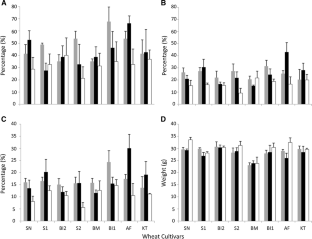Wheat grains damaged by Fusarium graminearum: alterations in yield, toxicity and protein composition
Ortega L. M., Moure M. C., Astoreca A. L., Alberione E. J., Alconada T. M.
Research Articles | Published: 26 August, 2019
Online ISSN : 2229-4473.
Website:www.vegetosindia.org
Pub Email: contact@vegetosindia.org
First Page: 593
Last Page: 599
Views: 1753
Keywords:
Wheat, Fusarium graminearum isolates, Gluten proteins, Deoxynivalenol, Statistic principal component analysis
Abstract
The aim of this study was to investigate alterations on wheat grains, in relation to yield and quality parameters, such as infection degree, protein composition and toxicity caused by isolates of Fusarium graminearum with different aggressiveness. The disease degree on wheat samples was evaluated by the parameters like incidence, severity, damaged kernels percentage, yield, deoxynivalenol content and protein constitution, which were analyzed employing accurate quantitative statistics. High and positive correlations among the disease degree parameters were found, as well as negative correlations between them and yield, meanwhile, the total protein content was correlated with yield but was not correlated with the disease degree. The data analysis showed that the effect of the isolate was more significant than the cultivar in the disease degree for almost all the studied variables. The variability in the content of the deoxynivalenol mycotoxin showed a positive tendency in relation to the infection degree. As a novel approach, the aggressiveness of the different isolates ranged from high to low allowing us to evaluate a wide range of the aftereffects of the disease.

(*Only SPR Members can get full access. Click Here to Apply and get access)
References
- Alberione EJ, Ortega LM, Salines N, Astoreca AL, Alconada TM (2016) Genetic behavior of different wheat genotypes against Fusarium graminearum. Agrociencia 50:335–346. http://www.redalyc.org/html/302/30246007006/
- Alvarez CL, Somma S, Moretti A, Fernández Pinto VE (2010) Aggressiveness of Fusarium graminearum sensu stricto isolates in wheat kernels in Argentina. J Phytopathol 158:173–181. https://onlinelibrary.wiley.com/doi/full/10.1111/j.1439-0434.2009.01596.x
- Astoreca A, Ortega L, Fígoli C, Cardós M, Cavaglieri L et al (2017) Analytical techniques for deoxynivalenol detection and quantification in wheat destined for the manufacture of commercial products. World Mycotoxin J 10:111–120. https://www.wageningenacademic.com/doi/abs/10.3920/WMJ2016.2121
- Capouchová I, Papoušková L, Kostelanská M, Prokinová E, Škeříková A et al (2012) Effect of different intensities of Fusarium infestation on grain yield, deoxynivalenol content and baking quality of winter wheat. Rom Agric Res 29:297–306
- Castañares E, Albuquerque DR, Dinolfo MI, Fernández Pinto VE, Patriarca A et al (2014) Trichothecene genotypes and production profiles of Fusarium graminearum isolates obtained from barley cultivated in Argentina. Int J Food Microbiol 179:57–63. https://www.sciencedirect.com/science/article/pii/S0168160514001470
- DuPont FM, Chan R, Lopez R, Vensel WH (2005) Sequential extraction and quantitative recovery of gliadins, glutenins, and other proteins from small samples of wheat flour. J Agric Food Chem 53:1575–1584. https://pubs.acs.org/doi/abs/10.1021/jf048697l
- Eggert K, Wieser H, Pawelzik E (2010) The influence of Fusarium infection and growing location on the quantitative protein composition of (part I) emmer (Triticum dicoccum). Eur Food Res Technol 230:837–847. https://link.springer.com/article/10.1007/s00217-010-1229-3
- FAO (2015) El estado de los mercados de productos básicos agrícolas 2015–16. http://www.fao.org/publications/soco/2015/es/. Accessed 4 Feb 2018
- Guarda G, Padovan S, Delogu G (2004) Grain yield, nitrogen-use efficiency and baking quality of old and modern Italian bread-wheat cultivars grown at different nitrogen levels. Eur J Agron 21:181–192. https://www.sciencedirect.com/science/article/pii/S1161030103000960
- Hernández Espinosa N, Posadas Romano G, Cervantes López F, González Santoyo HI, Santacruz Varela A et al (2013) Protein fraction distribution and their contribution to quality characteristics in wheat. Rev Fitotec Mex 36:137–145. http://www.citeulike.org/group/19839/article/13813907
- Horvat DI, Spanic V, Dvojkovic K, Simic GH, Magdic DN et al (2014) The influence of Fusarium infection on wheat (Triticum aestivum L.) proteins distribution and baking quality. Cereal Res Commun 43:61–71. https://akademiai.com/doi/abs/10.1556/CRC.2014.0023
- ISO (2013) International Standardization Organization 20483:2013 “Cereals and pulses—determination of the nitrogen content and calculation of the crude protein content—Kjeldahl method”. https://www.iso.org/obp/ui/#iso:std:iso:20483. Accessed 12 Aug 2019
- Malbrán I, Mourelos CA, Girotti JR, Aulicino MB, Balatti PA et al (2012) Aggressiveness variation of Fusarium graminearum isolates from Argentina following point inoculation of field grown wheat spikes. Crop Prot 42:234–243. https://www.sciencedirect.com/science/article/pii/S0261219412001718
- Ortega LM, Dinolfo MI, Astoreca AL, Alberione EJ, Stenglein SA et al (2016) Molecular and mycotoxin characterization of Fusarium graminearum isolates obtained from wheat at a single field in Argentina. Mycol Prog 15:1–8. https://link.springer.com/article/10.1007/s11557-015-1147-7
- Pariaud B, Ravigné V, Halkett F, Goyeau H, Carlier J et al (2009) Aggressiveness and its role in the adaptation of plant pathogens. Plant Pathol 58:409–424. https://onlinelibrary.wiley.com/doi/full/10.1111/j.1365-3059.2009.02039.x
- Torbica AM, Antov MG, Mastilović J, Knežević DS (2007) The influence of changes in gluten complex structure on technological quality of wheat (Triticum aestivum L.). Food Res Int 40:1038–1045. https://www.sciencedirect.com/science/article/pii/S0963996907000889
- Valle-Algarra FM, Mateo EM, Mateo R, Gimeno-Adelantado JV, Jiménez M (2011) Determination of type A and type B trichothecenes in paprika and chili pepper using LC-triple quadrupole–MS and GC–ECD. Talanta 84:1112–1117. https://www.sciencedirect.com/science/article/pii/S0039914011002220
- FAO (2003) Worldwide regulations for mycotoxins in food and feed, FAO Food and Nutrition Paper No. 81. Food and Agriculture Organization of the United Nations, Rome. http://www.fao.org/docrep/007/y5499e/y5499e09. Accessed 12 Aug 2019
- Mesterházy Á (2002) Role of deoxynivalenol in aggressiveness of Fusarium graminearum and F. culmorum and in resistance to Fusarium head blight. In: Logrieco AFR, Corazza L, Cooke BM (eds) Mycotoxins in plant disease. Springer, Amsterdam, pp 675–684. https://link.springer.com/chapter/10.1007/978-94-010-0001-7_10
Acknowledgements
Author Information
Centro de Investigación y Desarrollo en Fermentaciones Industriales, UNLP-CONICET, Facultad de Ciencias Exactas, La Plata, Argentina
Centro de Investigación y Desarrollo en Fermentaciones Industriales, UNLP-CONICET, Facultad de Ciencias Exactas, La Plata, Argentina
Centro de Investigación y Desarrollo en Fermentaciones Industriales, UNLP-CONICET, Facultad de Ciencias Exactas, La Plata, Argentina
Patología Vegetal del Cultivo de Trigo, Instituto Nacional de Tecnología Agropecuaria, Marcos Juárez, Argentina
Centro de Investigación y Desarrollo en Fermentaciones Industriales, UNLP-CONICET, Facultad de Ciencias Exactas, La Plata, Argentina
alconada@biotec.quimica.unlp.e